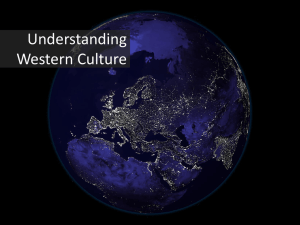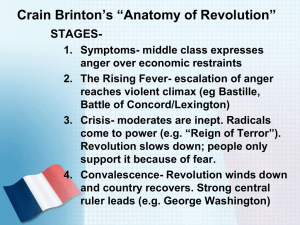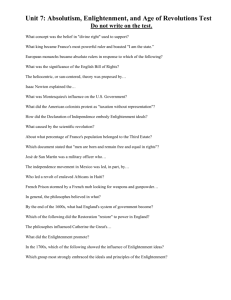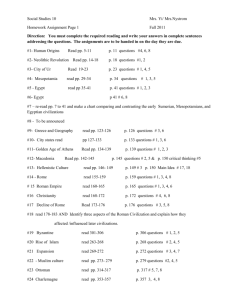AP EURO FRAMEWORK- STUDY GUIDE: Period 2
advertisement
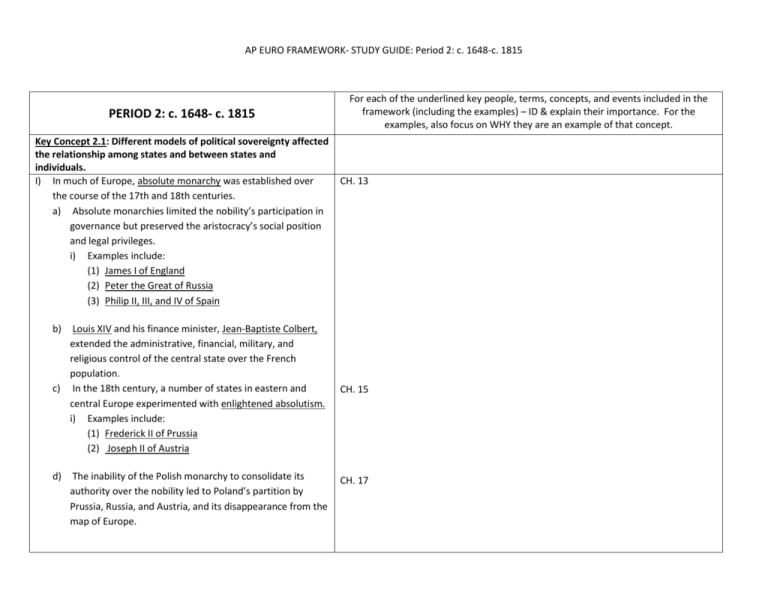
AP EURO FRAMEWORK- STUDY GUIDE: Period 2: c. 1648-c. 1815 PERIOD 2: c. 1648- c. 1815 Key Concept 2.1: Different models of political sovereignty affected the relationship among states and between states and individuals. I) In much of Europe, absolute monarchy was established over the course of the 17th and 18th centuries. a) Absolute monarchies limited the nobility’s participation in governance but preserved the aristocracy’s social position and legal privileges. i) Examples include: (1) James I of England (2) Peter the Great of Russia (3) Philip II, III, and IV of Spain For each of the underlined key people, terms, concepts, and events included in the framework (including the examples) – ID & explain their importance. For the examples, also focus on WHY they are an example of that concept. CH. 13 b) Louis XIV and his finance minister, Jean-Baptiste Colbert, extended the administrative, financial, military, and religious control of the central state over the French population. c) In the 18th century, a number of states in eastern and central Europe experimented with enlightened absolutism. i) Examples include: (1) Frederick II of Prussia (2) Joseph II of Austria CH. 15 d) CH. 17 The inability of the Polish monarchy to consolidate its authority over the nobility led to Poland’s partition by Prussia, Russia, and Austria, and its disappearance from the map of Europe. AP EURO FRAMEWORK- STUDY GUIDE: Period 2: c. 1648-c. 1815 e) Peter the Great “westernized” the Russian state and society, transforming political, religious, and cultural institutions; Catherine the Great continued this process. II) Challenges to absolutism resulted in alternative political systems. a) The outcome of the English Civil War and the Glorious Revolution protected the rights of gentry and aristocracy from absolutism through assertions of the rights of Parliament. i) Examples include: (1) English Bill of Rights (2) Parliamentary sovereignty b) The Dutch Republic developed an oligarchy of urban gentry and rural landholders to promote trade and protect traditional rights. III) After 1648, dynastic and state interests, along with Europe’s expanding colonial empires, influenced the diplomacy of European states and frequently led to war. a) As a result of the Holy Roman Empire’s limitation of sovereignty in the Peace of Westphalia, Prussia rose to power and the Habsburgs, centered in Austria, shifted their empire eastward. i) Examples include: (1) Maria Theresa of Austria (2) Frederick William I of Prussia (3) Frederick II of Prussia After the Austrian defeat of the Turks in 1683 at the Battle of Vienna, the Ottomans ceased their westward expansion. c) Louis XIV’s nearly continuous wars, pursuing both dynastic and state interests, provoked a coalition of European powers opposing him. CH. 15 CH. 13 CH. 15 CH. 15 b) CH. 13 AP EURO FRAMEWORK- STUDY GUIDE: Period 2: c. 1648-c. 1815 i) Examples include: (1) Dutch War (2) Nine Years’ War (3) War of the Spanish Succession d) Rivalry between Britain and France resulted in world wars fought both in Europe and in the colonies, with Britain supplanting France as the greatest European power. IV) The French Revolution posed a fundamental challenge to Europe’s existing political and social order. a) The French Revolution resulted from a combination of long-term social and political causes, as well as Enlightenment ideas, exacerbated by short-term fiscal and economic crises. b) The first, or liberal, phase of the French Revolution established a constitutional monarchy, increased popular participation, nationalized the Catholic Church, and abolished hereditary privileges. i) Examples include: (1) Declaration of the Rights of Man and Citizen (2) Civil Constitution of the Clergy (3) Constitution of 1791 (4) Abolition of provinces and division of France into departments c) After the execution of the Louis XVI, the radical Jacobin Republic led by Robespierre responded to opposition at home and war abroad by instituting the Reign of Terror, fixing prices and wages, and pursuing a policy of deChristianization. i) Examples include: (1) Georges Danton CH. 17 CH. 19 AP EURO FRAMEWORK- STUDY GUIDE: Period 2: c. 1648-c. 1815 (2) Jean-Paul Marat (3) Committee of Public Safety d) Revolutionary armies, raised by mass conscription, sought to bring the changes initiated in France to the rest of Europe. e) Women enthusiastically participated in the early phases of the revolution; however, while there were brief improvements in the legal status of women, citizenship in the republic was soon restricted to men. f) Revolutionary ideals inspired a slave revolt led by Toussaint L’Ouverture in the French colony of Saint Domingue, which became the independent nation of Haiti in 1804. i) While many were inspired by the revolution’s emphasis on equality and human rights, others condemned its violence and disregard for traditional authority V) Claiming to defend the ideals of the French Revolution, Napoleon Bonaparte imposed French control over much of the European continent that eventually provoked a nationalistic reaction. a) As first consul and emperor, Napoleon undertook a number of enduring domestic reforms while often curtailing some rights and manipulating popular impulses behind a façade of representative institutions. i) Examples domestic reforms include: (1) Careers open to talent (2) Educational system (3) Centralized bureaucracy (4) Civil Code (5) Concordat of 1801 ii) Examples of curtailing rights include: (1) Secret police CH. 20 AP EURO FRAMEWORK- STUDY GUIDE: Period 2: c. 1648-c. 1815 (2) Censorship (3) Limitation of women’s right b) Napoleon’s new military tactics allowed him to exert direct or indirect control over much of the European continent, spreading the ideals of the French Revolution across Europe. c) Napoleon’s expanding empire created nationalist responses throughout Europe. d) After the defeat of Napoleon by a coalition of European powers, the Congress of Vienna (1814-1815) attempted to restore the balance of power in Europe and contain the danger of revolutionary or nationalistic upheavals in the future. Key Concept 2.2: The expansion of European commerce accelerated the growth of a worldwide economic network. I) Early modern Europe developed a market economy that provided the foundation for its global role. a) Labor and trade in commodities were increasingly freed from traditional restrictions imposed by governments and corporate entities. i) Examples include: (1) Market-driven wages and prices (2) Le Chapelier laws b) The Agricultural Revolution raised productivity and increased the supply of food and other agricultural products. c) The putting-out system, or cottage industry, expanded as increasing numbers of laborers in homes or workshops produced for markets through merchant intermediaries or workshop owners. CH. 16 AP EURO FRAMEWORK- STUDY GUIDE: Period 2: c. 1648-c. 1815 d) The development of the market economy led to new financial practices and institutions. i) Examples include: (1) Insurance (2) Banking institutions for turning private savings into venture capital (3) New definitions of property rights and protections against confiscation (4) Bank of England II) The European-dominated worldwide economic network contributed to the agricultural, industrial, and consumer revolutions in Europe. a) European states followed mercantilist policies by exploiting colonies in the New World and elsewhere. b) The transatlantic slave-labor system expanded in the 17th and 18th centuries as demand for New World products increased. i) Examples include: (1) Middle Passage (2) Triangle trade (3) Plantation economies in the Americas c) Overseas products and influences contributed to the development of a consumer culture in Europe. i) Examples include: (1) Sugar (2) Tea (3) Silks and other fabrics (4) Tobacco (5) Rum (6) Coffee CH. 17 CH. 17 AP EURO FRAMEWORK- STUDY GUIDE: Period 2: c. 1648-c. 1815 d) The importation and transplantation of agricultural products from the Americas contributed to an increase in the food supply in Europe. E. Foreign lands provided raw materials, finished goods, laborers, and markets for the commercial and industrial enterprises in Europe. III) Commercial rivalries influenced diplomacy and warfare among European states in the early modern era. a) European sea powers vied for Atlantic influence throughout the 18th century. b) Portuguese, Dutch, French, and British rivalries in Asia culminated in British domination in India and Dutch control of the East Indies. Key Concept 2.3: The popularization and dissemination of the Scientific Revolution and the application of its methods to political, social, and ethical issues led to an increased, although not unchallenged, emphasis on reason in European culture. I) Rational and empirical thought challenged traditional values and ideas. a) Intellectuals such as Voltaire and Diderot began to apply the principles of the Scientific Revolution to society and human institutions. i) Examples include: (1) Montesquieu’s The Spirit of the Laws (2) Cesare Beccaria’s On Crimes and Punishments b) Locke and Rousseau developed new political models based on the concept of natural rights. c) Despite the principles of equality espoused by the Enlightenment and the French Revolution, intellectuals such as Rousseau offered new arguments for the exclusion of women from political life, which did not go unchallenged. i) Examples include: CH. 17 CH. 18 AP EURO FRAMEWORK- STUDY GUIDE: Period 2: c. 1648-c. 1815 (1) Mary Wollstonecraft (2) Olympe de Gouges (3) Marquis de Condorcet II) New public venues and print media popularized Enlightenment ideas. a) A variety of institutions, such as salons, explored and disseminated Enlightenment culture. i) Examples include: (1) Coffeehouses (2) Academies (3) Lending libraries (4) Masonic lodges b) Despite censorship, increasingly numerous and varied printed materials served a growing literate public and led to the development of public opinion. i) Examples include: (1) Newspapers (2) Periodicals (3) Books (4) Pamphlets (5) The Encyclopédie c) Natural sciences, literature, and popular culture increasingly exposed Europeans to representations of peoples outside Europe. III) New political and economic theories challenged absolutism and mercantilism. a) Political theories, such as John Locke’s, conceived of society as composed of individuals driven by self-interest and argued that the state originated in the consent of the governed (i.e., a social contract) rather than in divine right or tradition. CH. 18 CH. 14 AP EURO FRAMEWORK- STUDY GUIDE: Period 2: c. 1648-c. 1815 b) Mercantilist theory and practice were challenged by new economic ideas, such as Adam Smith’s, espousing free trade and a free market. i) Examples include: (1) Physiocrats (2) Francois Quesnay (3) Anne Robert Jacques Turgot IV) During the Enlightenment, the rational analysis of religious practices led to natural religion and the demand for religious toleration. a) Intellectuals, including Voltaire and Diderot, developed new philosophies of deism, skepticism, and atheism. i) Examples include: (1) David Hume (2) Baron d’Holbach b) Religion was viewed increasingly as a matter of private rather than public concern. c) By 1800, most governments had extended toleration to Christian minorities and, in some states, civil equality to Jews. V) The arts moved from the celebration of religious themes and royal power to an emphasis on private life and the public good. a) Until about 1750, Baroque art and music promoted religious feeling and was employed by monarchs to glorify state power. i) Examples include: (1) Diego Velásquez (2) Gian Bernini (3) George Frideric Handel (4) J. S. Bach CH. 18 CH. 18 CH. 16 SCATTERED THROUGHOUT KAGAN CHAPTERS! AP EURO FRAMEWORK- STUDY GUIDE: Period 2: c. 1648-c. 1815 b) Artistic movements and literature also reflected the outlook and values of commercial and bourgeois society as well as new Enlightenment ideals of political power and citizenship. i) Examples of artistic movements that reflected commercial society or Enlightenment ideals include: (1) Dutch painting (2) Frans Hals (3) Rembrandt (4) Jan Vermeer (5) Neoclassicism (6) Jacques Louis David (7) Pantheon in Paris I) ii) Examples of literature that reflected commercial society or Enlightenment ideals include: (1) Daniel Defoe (2) Samuel Richardson (3) Henry Fielding (4) Johann Wolfgang von Goethe (5) Jane Austen While Enlightenment values dominated the world of European ideas, they were challenged by the revival of public sentiment and feeling. a) Rousseau questioned the exclusive reliance on reason and emphasized the role of emotions in the moral improvement of self and society. b) Revolution, war, and rebellion demonstrated the emotional power of mass politics and nationalism. c) Romanticism emerged as a challenge to Enlightenment rationality. CH. 20 AP EURO FRAMEWORK- STUDY GUIDE: Period 2: c. 1648-c. 1815 Key Concept 2.4: The experiences of everyday life were shaped by demographic, environmental, medical, and technological changes. I) In the 17th century, small landholdings, low-productivity agricultural practices, poor transportation, and adverse weather limited and disrupted the food supply, causing periodic famines. By the 18th century, Europeans began to escape from the Malthusian imbalance between population and the food supply, resulting in steady population growth. a) By the middle of the 18th century, higher agricultural productivity and improved transportation increased the food supply, allowing populations to grow and reducing the number of demographic crises (a process known as the Agricultural Revolution). b) In the 18th century, plague disappeared as a major epidemic disease, and inoculation reduced smallpox mortality. II) The consumer revolution of the 18th century was shaped by a new concern for privacy, encouraged the purchase of new goods for homes, and created new venues for leisure activities. a) Examples of a new concern for privacy include: i) Homes were built to include private retreats, such as the boudoir ii) Novels encouraged a reflection on private emotions b) Examples of new consumer goods for homes include: i) Porcelain dishes ii) Cotton and linens for home décor iii) Mirrors iv) Prints c) Examples of new leisure venues include: i) Coffeehouses ii) Taverns iii) Theaters and opera houses CH. 16 CH. 16 AP EURO FRAMEWORK- STUDY GUIDE: Period 2: c. 1648-c. 1815 III) By the 18th century, family and private life reflected new demographic patterns and the effects of the commercial revolution. a) Although the rate of illegitimate births increased in the 18th century, population growth was limited by the European marriage pattern and, in some areas, by the early practice of birth control. b) As infant and child mortality decreased and commercial wealth increased, families dedicated more space and resources to children and child-rearing, as well as private life and comfort. III) Cities offered economic opportunities, which attracted increasing migration from rural areas, transforming urban life and creating challenges for the new urbanites and their families. a) The Agricultural Revolution produced more food using fewer workers; as a result, people migrated from rural areas to the cities in search of work. b) The growth of cities eroded traditional communal values, and city governments strained to provide protection and a healthy environment. c) The concentration of the poor in cities led to a greater awareness of poverty, crime, and prostitution as social problems, and prompted increased efforts to police marginal groups. CH. 16 CH. 216

